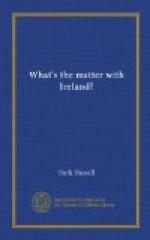III
IRISH LABOR AND CLASS REVOLUTION
“A change of flags is not enough.”
In the sputtering flare of the arc lamp in front of Liberty hall stood squads of boys. Some of them wore brass-buttoned, green woolen waists, and some, ordinary cotton shirts. Some of them had on uniform knickers, and some, long, unpressed trousers. On the opposite side of the street were blocked similar squads of serious-eyed, high-chinned girls. Some of them were in green tweed suits, and others as they had come from work. They were companies of the Citizens’ Army recruited by the Irish Labor party, and assembled in honor of the return of the Countess Markewicz from jail.
“Though cowards flinch and traitors
sneer,
We’ll keep the red flag flying here.”
Young voices, impatient of the interim of waiting, sang the socialist song. The burden was taken up by the laborers, whose constant movement to keep a good view was attested by the hollow sound of their wooden-soled boots on the stone walks. And the refrain was hummed by the shawled, frayed-skirted creatures who were coming up from Talbot street, Gloucester street, Peterson’s lane, and all the family-to-a-room districts in Dublin. On the skeletonish railroad crossing suspended over the Liffey, tin-hatted and bayonet-carrying British soldiers were silhouetted against the moon-whitened sky. Up to them floated the last oath of “The Red Flag”:
“With heads uncovered swear we all,
To bear it onward till we fall.
Come dungeon dark or gallows grim,
This song shall be our parting hymn.”
Clattered over the bridge the horse-dragged brake. In the light of a search lamp played on it from an automobile behind, a small figure in a slouch hat and a big black coat waved a bouquet of narcissus. There was a surge of the block-long crowds and people who could not see lifted their hands and shouted: “Up the countess!”
As we waited in the light of the dim yellow bulbs threaded from the ceiling of the big bare upper front room of Liberty Hall, Susan Mitchell told me of “the chivalrous woman.” The countess is a daughter of the Gore-Booth family which owned its Sligo estate before America was discovered. As a girl the countess used to ride fast horses like mad along the rocky western coast. Then she became a three-feathered debutante bowing at Dublin Castle. Later she painted pictures in Paris and married her handsome Pole. But one day some one put an Irish history in her hands. In a sudden whole-hearted conversion to the cause of the people, the countess turned to aid the Irish labor organizers. She drilled boy scouts for the Citizens’ Army. She fed starving strikers during the labor troubles of 1913 with sheep sent daily from her Sligo estate. In the rebellion of 1916 she fought and killed under Michael Mallin of the Citizens’ Army. She was hardly out of jail for participation in the rebellion when she was clapped in again for alleged complicity in the never-to-be-proved German plot. While she was in jail, she was elected the first woman member of parliament.




